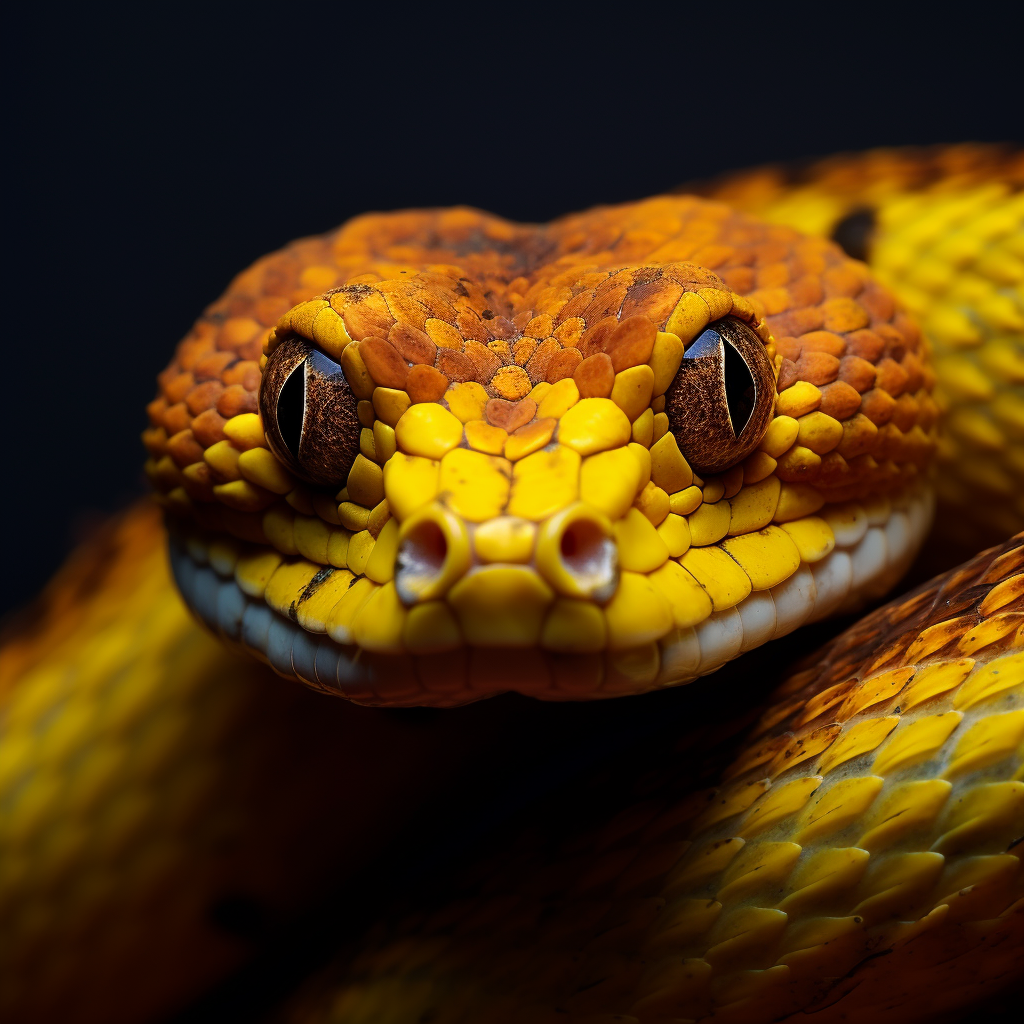Table of Contents
ToggleIntroduction
The Eyelash Viper is one of the world’s most visually captivating and enigmatic snake species. Its distinctive appearance, intriguing behaviors, and evil nature fascinate herpetologists, reptile enthusiasts, and those fortunate to encounter it in its native habitats.
This article delves into the various facets of the Eyelash Viper’s life, from its physical characteristics and habitat to its behavior, diet, venom, reproduction, and conservation status.
Physical Characteristics
Eyelash-Like Scales
The Eyelash Viper derives its common name from the unique scales above its eyes resembling long eyelashes or eyebrows. These specialized scales on its brow ridge give the snake an unmistakable and captivating appearance. They serve as aposematism, warning potential predators of the snake’s vicious nature.
Color Variation
One of the Eyelash Viper’s most remarkable physical characteristics is its diverse coloration. This snake species exhibits various colors ranging from vibrant green and yellow to more subdued shades of brown and gray. Some individuals showcase iridescent scales that shimmer in the light, enhancing their visual allure and blending seamlessly with their natural surroundings.
Size and Body Structure
Eyelash Vipers typically grow between 24 and 32 inches (60 and 80 centimeters) in length, with females often being more significant than males. They can maneuver more quickly through the dense undergrowth of their rainforest and cloud forest habitats thanks to these animals’ thin and elongated body form.
Habitat And Distribution
Habitat Diversity
Eyelash Vipers are well-adapted to the lush rainforests and cloud forests of Central and South America. They inhabit various environments, including lowland rainforests, montane regions, and coffee and cacao plantations. Their ability to thrive in such diverse habitats underscores their ecological flexibility.
Geographic Range
You may find Eyelash Vipers from the southernmost tip of Mexico, through Central America, and into the upper reaches of South America. Countries such as Costa Rica, Panama, Colombia, Ecuador, and Venezuela are good examples of where you might find them. Different features, such as altitude, climate, and vegetation, characterize the areas of these countries that they call home within each of these countries.
Behavior And Diet: Masters Of Camouflage
Arboreal Lifestyle
The Eyelash Viper is predominantly arboreal, meaning it spends much of its life in trees and shrubs. Its prehensile tail is a remarkable adaptation that enables it to navigate the branches easily. This arboreal lifestyle contributes to its striking camouflage and ability to remain hidden among the foliage.
Camouflage and Mimicry
The snake’s eyelash-like scales and stunning color help it blend into its surroundings and fool potential predators. The Eyelash Viper’s appearance makes it possible to closely mimic twigs, leaves, or even bark, making it an extremely successful ambush predator. Because of its camouflage, it is undetectable to both potential prey and dangerous predators.
Ambush Hunting
The Eyelash Viper employs an ambush hunting strategy. It remains concealed among the vegetation, patiently waiting for unsuspecting prey to pass by. Once the game comes within striking distance, the snake rapidly strikes and injects its venom, immobilizing the prey before swallowing it whole. This strategy requires precision and efficiency, and the snake’s physical adaptations are crucial to its success.
Venom: The Hidden Weapon
Venom Composition
The Eyelash Viper is a venomous snake that carries a predominantly hemotoxic venom, affecting the blood and its prey’s circulatory system. The enzymes and toxins that make up the toxin work together to break down tissue and help the snake kill its target.
Even though its venom is highly toxic, it is not usually considered fatal to people. It is the case, however, unless the human in question has an allergy or an extraordinary sensitivity to the venom.
Defense Mechanism
The Eyelash Viper’s venom is both an offensive weapon and a defense mechanism. The snake can quickly strike when threatened, injecting venom into its attacker or potential threat. Its distinctive coloration and mimicry act as a warning signal, deterring predators from approaching.
Reproduction: The Continuation Of The Species
Ovoviviparous Reproduction
Ovoviviparity is an exciting way of reproduction, and the Eyelash Viper displays this mode of reproduction. Unlike oviparous species, which generate offspring by laying eggs, the female Eyelash Viper carries the developing embryos within her body until it is time for them to hatch. At this stage, the seeds obtain their nourishment from a yolk sac.
Live Birth
After the embryos have reached their maximum developmental potential, the female gives birth to young, still alive. Because of this procedure, the kids are born fully formed and prepared for life outside their mother’s body, increasing the likelihood that they will survive. The number of offspring produced by a single litter might range from a few to more than a dozen.
Conservation Status: A Fragile Future
Threats and Conservation
Although the Eyelash Viper is not on the IUCN Red List of Endangered Species, its conservation status varies significantly throughout its populations and geographic locations.
Like many other snake species, the Eyelash Viper faces an existential threat due to the destruction of its natural habitat due to human development and deforestation. The loss of its rainforest habitats directly and negatively influences the animal’s capacity to locate food, housing, and breeding grounds that are ideal for them.
Importance of Biodiversity
The Eyelash Viper is a crucial component of the ecosystem it inhabits. As an apex predator, it helps regulate the populations of its prey species, contributing to the delicate balance of the rainforest ecosystem.
Protecting the habitats of the Eyelash Viper is crucial not only for its survival but also for the overall health and biodiversity of the regions it calls home.
Conclusion
The Eyelash Viper emerges as a compelling and symbolic dweller in the verdant tapestry of the rainforests of Central and South America. Its exquisite design, which is a monument to the creativity of nature, demonstrates the marvels of adaptation that enable it to blend in perfectly with the environment in which it lives. The stunning physical characteristics of the snake, such as its scales shaped like eyelashes and its varied color palette, highlight the natural beauty resulting from evolution.







